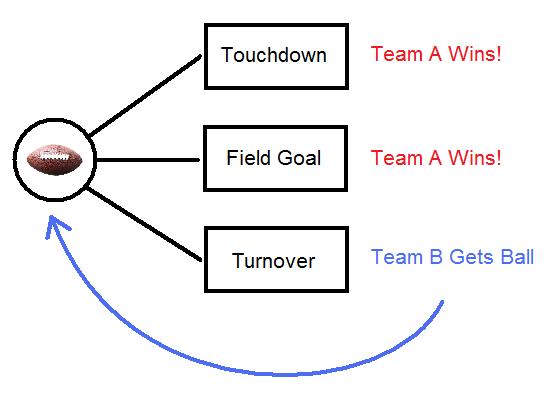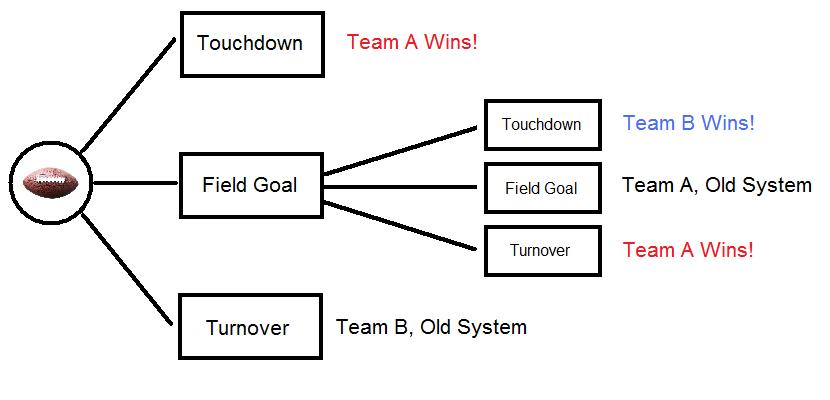New NFL Overtime Rules and Strategy
At the beginning of the 2011 playoffs, the NFL implemented a new set of overtime rules that drastically altered how tie games would be decided. The rules entail many significant strategic consequences, and I’m not sure how well-understood those consequences are.
The old overtime rule is straightforward: initial possession of the ball in overtime is determined by a coin-toss, and the first team to score is the winner. Critics of this model argued that since initial possession of the ball was such an advantage, awarding it based on a coin-toss essentially made the outcome of the game equivalent to a coin-toss. The argument seems reasonable, although whether the data backs it up is a story for another time.
The NFL’s new system tries to counterbalance the advantage of initial possession. From here on out, let’s call the team that wins the coin-toss, and therefore begins overtime with the ball, Team A. In the new system, Team A can win the game on its initial possession only if they score a touchdown. If Team A scores a field goal on their initial possession, Team B will receive the ball and have a possession to then try to win or tie the game.
Here is a diagram illustrating the old system. The basic idea here is if Team A scores, they win. If they don’t, then Team B gets the football and starts at the front of the graph.
The basic idea here is if Team A scores, they win. If they don’t, then Team B gets the football and starts at the front of the graph.
Here’s a graph representing the new system.
This system is far more complex. First of all, Team A now has a great incentive to try for a touchdown on its first possession, whereas under the old system, they had virtually no incentive to do so. Furthermore, the value of a field goal for Team A on its initial possession has been greatly decreased. Under the old system, a first-possession field goal won the game. Under the new system, its value is considerably less. What are the consequences of these new realities?
What are the consequences of these new realities?
Consider a long field goal on the initial possession. Make it, and your opponent gets the ball and can beat you with a touchdown or tie you with a field goal. Miss it, and your opponent will have good field position and now can beat you with a field goal. Perhaps punting is the better option: you gain field position and if you defend successfully, you get the ball back and now all you need is a field goal to win.
Even more interesting is a short field goal attempt on the initial possession. Make it, and your opponent still gets field position and a chance to beat or tie you. Why not go for a touchdown? You win outright if you succeed, and if you don’t, not only does your opponent get poor field position, but if you defend successfully you’ll only need a field goal to win.
Because of the altered values of touchdowns and field goals mentioned above, I think 4th down strategies on the initial possession should be modified as well. As complex as it is, at least the new system reverts to the old ruleset after (at most) two possessions.
As interesting as the many consequences of these rule changes are, I still think the “first to six” idea makes more sense. We’ll see what happens this weekend!
Related Posts
6 Comments
Kazi Ali · January 8, 2011 at 2:33 pm
I think the new rule implemented makes much more sense than the original rule. But I still think there shouldn’t be the idea of a “golden goal”, which means the first to score essential 6 points wins. I think the team should be allowed to play through the OT like they do in NBA which would create more opportunities and if still tied then implement this rule. In the NFL overtime, the game changes from a battle of field position (in regulation) to a battle of who can score first. This changes all coaching strategy and gameplans immensely.
James T · January 8, 2011 at 5:41 pm
I agree with Kazi above. Why not have a set amount of overtime time on the clock and the team with the most points after this time scores? This would reduce almost any advantage that comes with winning the coin toss. In addition, more strategy can be used. And let’s not forget this: the longer a football game is on television, the more money the NFL gets from marketing. It seems a win-win situation. One last question; In the second graph above, it says that if Team A scores a field goal, then Team B makes a turnover on their possession, then Team A wins?Is this a mistake?
MrHonner · January 8, 2011 at 8:14 pm
You guys both make some relevant points. The set overtime period (say 15 minutes) seems the fairest solution, but what I’ve read on the matter suggests that many of the owners really like the “sudden death” element of OT, and so wanted to make sure that aspect was preserved.
James, I think the graph is correct: if Team A scores a FG on the first possession of OT, then Team B is given one possession to either win the game with a TD (game ends) or tie the game with a FG (at which point the rules essentially reverts to the old system).
James T · January 9, 2011 at 4:40 pm
Thank you for your reply. I now realize I read the graph wrong.
Kathryn · January 12, 2012 at 7:07 pm
This post was so relevant to what happened this past weekend!
What do you think about the NFL rules compared with the College Football rules? I think CFB is more fair – but allowing them to get the ball at the 30 is essentially ensuring a touchdown, which makes the FG/TD situation more complicated. Unless the team has a bad kicker and you have a good defense (which is not rare to have a bad kicker in college, by the way), you should always go for the FG if its 4th down, because they get the ball almost in FG range, so if you don’t get any points, it is extremely likely for the other team to get a field goal.
Great post! 🙂
MrHonner · January 15, 2012 at 11:25 pm
I’m not a big college football fan, so I don’t watch a lot, but I definitely don’t like the way their overtime rules work. It’s just so different from the way the game is played for 60 minutes.
And I agree with your analysis–it’s doesn’t seem very useful to kick a FG in OT in college, although as in the pro situation, there probably are some situations where it is the best option.